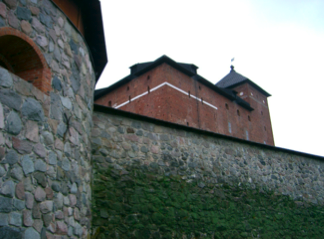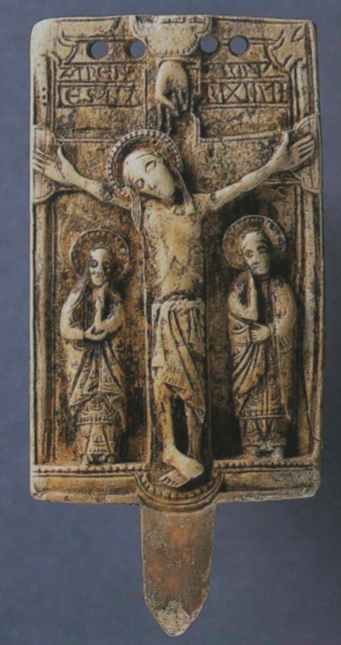Chapter 10. Leaving Hattula [August 16, 1347]
Cultural Explanations
 |
Chapter 10. Leaving Hattula [August 16, 1347] Cultural Explanations |
|
 |
In this chapter Bávlos describes a Eucharistic vision to the priest at Hattula and receives a letter to bring to the bishop of Turku |
| Pekka departing from Bavlos and Nieiddash |
In this chapter, Bávlos discusses his Eucharistic experience with Father Jens, the Swedish-born priest in charge of the remote parish at Hattula. Father Jens recognizes Bávlos's mystical tendencies and views his vision as important enough that he urges Bávlos to consult with Bishop Hemming at Turku. It was a bishop's responsibility to investigate and possibly condemn or endorse mystical visions that arose in his diocese. The bishop needed to distinguish divinely sent messages from those arising from the mere ignorance of common people or, even more ominously, from demonic sources. Father Jens acts dutifully in referring Bávlos to the bishop after hearing of his supernatural experiences.
Part of the wonder of the vision which Bávlos describes is the fact that the voice speaks to him in a language he does not yet know: Father Jens's native language of Swedish. The words which Bávlos hears during his vision are what linguists term Old Swedish, albeit pronounced with a Sámi accent. It is possible that Bávlos and his family would have heard some form of Swedish occasionally among traders and tribute collectors in their home region and would have gained at least a passive knowledge of some basic commands and expressions. He does not know the language by its name, however, and mistakes it for what he assumes to be Latin. Whereas Finnish and Sámi are related languages, Swedish is substantially different in form and vocabulary, and will pose a considerable challenge to Bávlos in coming chapters. We have already heard Pekka complain bitterly of his difficulties learning Swedish during his time in Skellefteå. For an English-speaker, of course, the opposite is true: Swedish seems very easy to learn, while Finnish and Sámi are the ones which prove more challenging. English and Swedish are both Germanic languages and share much in terms of vocabulary and grammar. Further, Old Norse was brought by Scandinavians to England during the Viking Age and many Scandinavian words were borrowed into Old English at the time. You can see this in the words that Bávlos hears in his vision: the Swedish verb komma here is a cognate with the English come, and therefore fairly easy to learn, while the Sámi command form of the same verb Boaðe! or the Finnish equivalent Tule! are far different.
The idea of Father Jens having come from Sweden to the church at Hattula is not improbable. Sweden and Finland were united under a single crown, but the western part of the realm (modern Sweden) was far more securely Christianized by this time than the east, and many cleargymen in both areas spoke Swedish as their native language. Sweden was also the land of aristocratic privilege, the breeding grounds for nobles, magistrates, and clerics who might receive offices in Finland as favors from powerful friends or relatives. Bishops to Finland were generally appointed from among the Swedish clergy, and probably learned Finnish only gradually during their time in office. Father Jens, as a Swedish-speaking priest, would have served well at Hattula, which was located near the castle of Hämeenlinna, a major fortress in the region. Hämeen linna had been constructed as a military outpost, intended both to keep the forces of Novgorod from invading the kingdom and to prevent the native populace of Finland from organizing any uprising against royal control. The last such revolt had occurred about a hundred years earlier in 1236-37. The people of Häme had revolted strongly against the rule of Bishop Thomas of Åbo, an English-born bishop (Eino Jutikkala and Kauko Pirinen, A History of Finland; Espoo: Weilin + Göös, 1984, p. 30). At that time, the fortress at Hämeenlinna was an important installation for preventing the Finns from throwing off the Swedish yoke. Father Jens alludes to plans to expand the castle in the near future and his hopes that he will have more company at that point. The castle as we see it today is much augumented by renovations of later centuries, which began soon after the rebuilding of the church at Hattula.
 |
| Hämeen linna, the Castle of Häme province, as it looks today |
The archdiocese of Finland used a single liturgy during the medieval period, the Dominican rite of the Order of Preachers, i.e., Pekka's order. For details of what that liturgy would have looked and sounded like during this period, see the work by Augustine Thompson O.P., Cities of God (University Park: Pennsylvania State University Press, 2005). The Dominicans played a central role in Nordic missionization and developed preachers capable of reaching Finns in their native language. This service must have greatly aided the secular priests like Fr. Jens, who spoke Finnish only as a secondary language. The mass was conducted in Latin, of course, and the priest faced away from the congregation, leading them in what was regarded as a communal address to God. The altar was separated from the laity by a screen that partially obscured the laity's view of the liturgical acts. The Eucharist was shared with the laity only occasionally, and very seldom in large cathedrals or urban areas unless it was a major feast day. Instead, priests blessed small loaves of bread (Eulogia) after the mass which could then be handed out to the laity to take home and share in their families. These loaves or buns were usually made by parish women. In a small church in which the number of participants at the mass was few, however, it was possible for the priest to distribute sacred hosts to the laity, provided they were proper Christians. It is not clear whether Bávlos's level of instruction in the faith at this point would have made him qualified to receive the Eucharist if Father Jens had known about his past. The sacramental wine of the mass was never shared with the laity at this time, although mystics in Central Europe greatly urged a change in this regulation.
Also distinctive about the medieval mass was the kissing of the pax, a small relief sculpture of wood, ivory, or metal that usually depicted some image of Christ, the crucifixion, or members of the Holy Family. The object was kissed first by the priest and his attending assistants, and then in turn by the entire congregation. In this way, all participants of the mass would have shared in a communal kiss of peace, even if they did not share in the Eucharist. The use of such pax panels is known for medieval Scandinavia from written records, but for many centuries there was no known surviving example from the Nordic region. Then in 1998, a walrus ivory pax was discovered in archaeological remains at Lönsås church in Östergötland. The pax depicts a crucified Christ flanked by Mary and St. John, with a Roman and runic inscription above. The object looks well worn and was undoubtedly used as a communal kissing device for a long time.
 |
| Pax panel of walrus ivory, early fourteenth century. Image courtesy Gustavson et al. |
If you read Swedish, there is a great article about this object :
Gustavson, Helmer, Marie Skoglund Ohlsén, and Göran Tegnér. "En medeltida paxtavla från Lönsås kyrka." Fornvännen 94 (1999): 169-177.